Are you looking into setting up a low-tech planted aquarium but don’t have any experience? There are many sources on the internet that you can use to learn the perfect method but many of them are very confusing and promote their products.
However, this guide is nothing like the others! We have explained everything comprehensively and we have used very simple terms so that you can easily understand and use what you learn here.
This article is a guest post by FishTankSetups.com.
What are Low-Tech Planted Aquariums?
Low-tech planted aquariums are those which require minimal maintenance and sometimes even no maintenance. They also do not require you to change the water of the tank as often. Moreover, you do not have to worry about the CO2 levels at all. These aquariums are much more beautiful and attractive (hardware wise) than others as they have less visible wires present.
The plants in these tanks do not grow at a very fast rate so you will not have to worry too much about trimming them every other week. However, you will have to cut them monthly otherwise they will overgrow and overcrowd your tank.
How to Setup Your Low-Tech Planted Aquarium (Step-by-Step):
Now that you know what they are, why should you get a low-tech planted aquarium? What are the precautions that you should beware of before getting your hands messy? It’s time to start setting up your low-tech planted aquarium.
We have listed the main steps that you should follow below:
1. The Base of the Aquarium (Substrate)
Making sure you have the best substrate for a planted aquarium is always the first thing to consider. It is essential for you to choose the right substrate. Otherwise, you will end up with problems such as your plants dying. You should go for any substrate that’s rich in nutrients and has granules that can for sure let your plants thrive. Great options are ADA soil or Eco-Complete.
*Caution when choosing topsoil.
You might see some people using topsoil capped with a layer of gravel for their low-tech planted aquarium. They do this to save money. However, before going for this particular soil substrate you should know that things can get very messy. If for any reason you need to move/remove a plant (that already established its roots) the soil underneath will surface and cloud your tank, leaving you with a partially muddy tank.
If you don’t know what you’re doing I highly recommend using aqua soil. This also allows you to re-use the soil in the future if you either need to replace or upgrade a tank. In the end, you’re saving money this way instead of going with the topsoil approach.
Ammonia is another problem that you should be concerned about when choosing soil because high ammonia levels can result in harmful algae that might harm your plants. Nevertheless, the soil is very important for the tank so, people use fertilizers for preventing the harmful effects of the soil.
2. Lighting for a Low-Tech Aquarium
When choosing a light for your low-tech planted tank you don’t really need to look for anything too fancy. I highly recommend buying an aquarium LED light. They get the job done and they require less energy than other types of lights on the market.
Some of the best lights I’ve seen are:
- Current USA Satellite Freshwater LED Plus Light
- Finnex Planted+ 24/7 Fully Automated Aquarium LED Lights
- The Finnex FugeRay Planted+
3. Planting
This is one of the most important steps when setting up an aquarium. Firstly, head over to your local fish store to look for low-light plants. (As you can tell by the name) they require less light to grow which makes them perfect for low-tech aquariums. The list of low-light aquarium plants from PlantedTank.net might help.
After all the plants are established perfectly, you should slowly remove the fast-growing plants, as they will pose a problem in the future. These plants take up all the nutrients and leave almost nothing for the others. Removing them too quickly may cause your tank to crash since they aid in removing nitrates from the water.
The high biomass of the plants is very important for their growth. You should always keep your tank free from harmful algae. It will ruin the aesthetics and it will take most of the vital nutrients too. Just remember these facts and you will have the perfect aquarium.
4. Filtration
For the constant purification of the tank, you should add a filter. An excellent filter with a good flow can do wonders, canister filters usually work best. You will have to make sure that you have installed the filter perfectly to get the maximum output from it. You should always place the intake in an open area. I highly recommend using filters without activated charcoal if you plan to use fertilizing in your aquarium.
Maintaining a filter is very easy as well, just make sure that you clean it every once in a while.
5. Fish for a Planted Aquarium
Here are some fish that great for planted aquariums:
- Neon Tetras
- Rainbow Fish
- Discus
- Angel Fish
- Swordtail Fish
Here is a tip: make sure your filtration can handle your bioload. Get a filter that’s recommended for a larger aquarium. However, remember not to add too many fish, you want your plants to stand out as well!
6. Fertilizers
You should get high-quality fertilizers for the aquarium since you don’t have Co2 aiding your plant growth. The dosage of the fertilizers should be given once in a week or two (depending on the size of your tank). You can easily calculate the fertilizer requirement for your tank by using this ratio.
Any local fish store should have fertilizers available. I highly recommend ordering online if you can’t find any locally as they will help your plants thrive.
For better natural growth of the plants. You should skip the fertilizer process once in a while. It will help the plants to remove any excess nutrients to fight algae.
For more in-depth information on fertilizers take a look at AquariumAdvice. They cover everything you need to know about aquarium fertilizers.
Conclusion
Now after knowing everything about low-tech planted aquariums, you can go and buy the necessary equipment and parts and set it up. If you follow this article the right way, you can have a magnificent aquarium of your own. You just have to be a little patient, as the plants will take a bit of time to grow up. Overall, we hope that you successfully set up your very own low-tech planted aquarium.
If you have any more questions about setting up a low-tech planted aquarium or if you want to share your own experiences, don’t hesitate to leave a comment below.

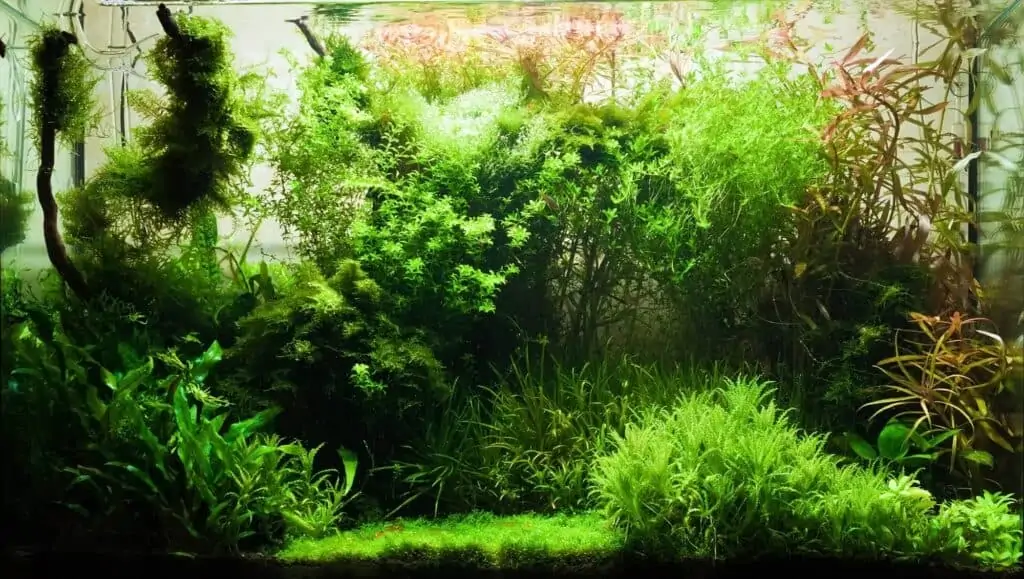

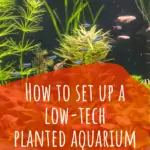
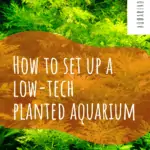
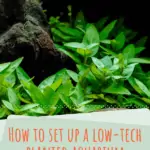

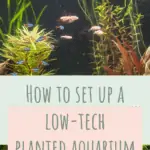
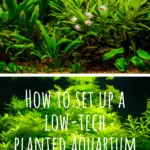
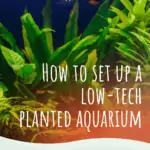
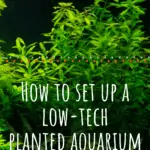
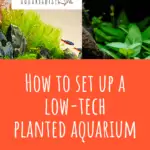
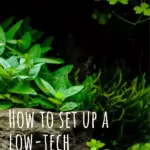
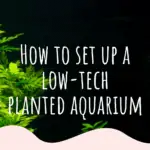
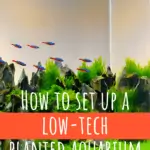
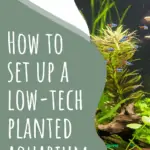
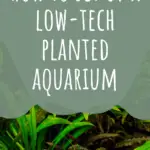
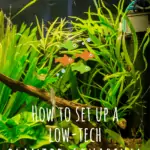
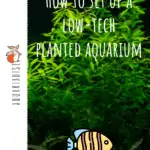
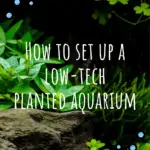
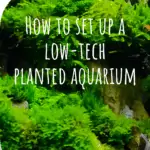
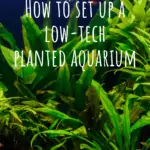
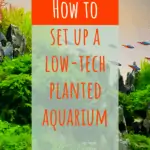
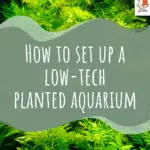
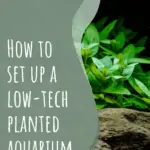
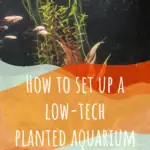
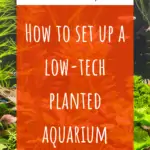
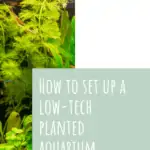
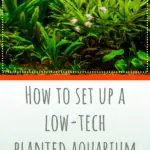

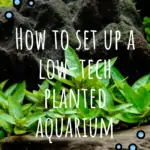
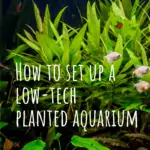
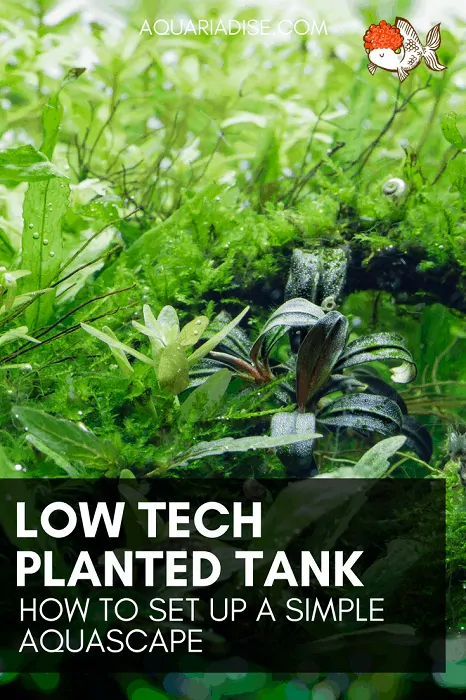

I found a picture on Instagram and it leads me here to your website,I can’t seem to find the actual picture on here though…it’s a tank with lots of under water plants but also some type of vines growing from the top up and outside the tank, sort of viney with small leaves. I’d love to know what these plants are if possible, I would be so grateful! There is also a betta fish in the tank if that helps, it’s a square shape and probably about a 6 gallon tank. I’m not sure what the technical name is for this tank where you have both under water plants and above surface plants but it’s what my goal tank is. Thank you!
Hi Jennifer!
I’m not sure I know which picture you’re talking about either.
A popular vine plant used in aquariums is pothos. Could that be it?
Tanks with both aquatic plants and terrestrial plants are called vivariums.
I hope this helped! Sorry I couldn’t find the exact picture.
Hi-I just purchased some live plants several days ago and they are showing some worrying signs-yellowing leaves near the base of the cryptocorn and a hole in one leaf on the Anubius. Also java fern with brown patches and holes. Do you know what could be the problem? I have the standard led that came with my tank and sand gravel mix substrate. No CO2 and a good amount of fish. I buried fertilizer tablets in gravel under the plants when I planted them…. any ideas what is wrong?
Thank you:)
Hi Malory!
I’m actually having the same problem right now in my tank with holes starting to appear in the middle of my Anubias, though they’re not new to the system. If you’ve just added these plants, a little melt is likely to happen as they adjust to your tank parameters; it’s even more likely to happen if you bought them emersed and transitioned them to submersed. Just try to prune back your plant and let it adjust to your tank.
If you’re noticing these problems in established plants, then it’s a nutrient/light problem. Holes in leaves is usually indicative of a potassium deficiency. The yellowing could be due to inadequate lighting, though these aren’t particularly light-demanding species; just make sure that large portions of the plant aren’t in shaded areas of the tank. Otherwise, it could be a nutrient deficiency too, whether it be nitrate, phosphate, iron, or something else.
My best guess is that these plants are just adjusting to the tank as it seems you have enough natural bioload and the extra root tabs. Just prune back whatever looks like it’s dying!
Good luck! Let us know how it goes.
Hello Mari,
I am an amatrice aquarier and I bought an Anubia 2 weeks ago which is in a pot and put it in my aquarium.
The last days I ‘ve noticed that the leaves are turning brown. I am afraid that is getting rotten.
Taking into consideration that my aquarium hasn’t any solar light at all, is there is something I can do to save the plant?
Antigone
Hello! Is your Anubias still in the little pot it came in? It should ideally be planted on rock or driftwood and it might not enjoy being stuck in the pot. Also, what do you mean by solar light? No direct sun or no light in general? If it doesn’t have a light you’ll have to look into getting one – it’s a must for growing plants, even very low-light ones like Anubias. Both of those factors could be contributing to the issue you’re having.
I have a full Anubias caresheet here that is probably helpful.
Hope that helps! And hope the Anubias pulls through 🙂
By going down the low-tech low light side … will there be any benefit to using a pressurised CO2 system on a low bubble count to help plant growth further or will it create more issues since lighting is low and fert regime is very low?
I think it could be of some use as long as you figure out the right balance. I guess you’d have to do some testing to figure out if it would help your plants. Although I’m not sure if you can still call it low tech if you’re running Co2… 😉
Hi do you have a recommendation on a heat lamp?
Any info on testing water?
What does good maintenance look like?
My daughter wants nothing but a red ear turtle for her birthday so I’m trying to setup a tank for simple success (new to turtles, I only know fish).
Really appreciate this wonderful article.
Hello!
I would recommend going through some turtle forums and reading product reviews for a heat lamp.
API test kits are popular sets for testing water parameters. You will need to test daily while the tank is cycling, but then you can test every other week or even once a month.
Good maintenance is a happy pet. Keep the tank clean, keep the food and water dishes fresh, and watch out for any abnormal behaviors.
Does a plant-only tank use a filter?
It might! It depends entirely on your own preferences. I do like to use one myself 🙂
Hi it’s me again I was wondering if I neede to put any specific lighting if my tank already has one
You mention you have a Fluval tank – the lights on those are known to be pretty “meh”, but it could work if you go super low tech. That means the lowest light plants only, like Anubias (caresheet here, I’d go with the “nana” cultivar as the regular ones are probably a little too big) and Java fern (caresheet here). No extra fertilizer, Co2 or anything else needed for those, you just have to tie or superglue them to rock or driftwood as they don’t like growing in the substrate. If you have any more questions feel free to ask!
I was wondering if it was possible to set up a hang-on-back filter if the water is fairly far below the rim? My aquarium has a lid but I wanted to add some rocks that would be above the surface.
Thanks
I think the only way to answer this question is to whip out the measuring tape. I think an average HOB intake pipe is around 15cm/6″ (maybe a little less), so if your water level is lower than that it won’t be an option.
And also, could fertilizers be left until a month or so later, or must I add them at the start? If not, is there anything that can be added later on?
Thank you, you’ve been very helpful
No problem. 🙂
I think it kind of depends on the plants. If the species you choose are not overly fussy/difficult then sure, you can leave it for a bit. I don’t use fertilizers at all myself because I only go for very undemanding species!
Good luck!
Hi Mari its me again I was wondering, lately I’ve really wanted to go more into specifics with fish care and tanks so I could learn how take care of my fish tanks better and maybe even get a bigger one and become a “pro” so was wondering if it wouldn’t cause so much trouble if you could send me something with all the specifics I could start on . Thank you so much for everything and may you be blessed and have a wonderful life full of fish
Glad to hear you’re doing plenty of research. I can’t exactly type out a list for you but luckily I’ve got a few of articles that contain information for beginners. They are located in the setting up an aquarium tag! They should help point you in the right direction.
I was also wondering if I need a more specialized filter if my tank already has a filter, my tank is a 5 gallon fluval
If you rehome your guppies and pleco and go for just a few inverts or maybe a betta as the “stocking a 5 gallon tank” article describes then no, your tank doesn’t need a more specialized filter. The fluval filters can be a little annoying from what I’ve heard but there’s definitely nothing wrong with them.
I absolutely love your web page. I really want to get involved with my fish and have been ready a bit from your page. I was wondering if it was best to use sand or gravel Inthink it might be gravel but I’ve always wanted to try sand and also I’m still a little confused on what substrate is.? Thank you so much you’ve really been helpful.
Glad you like the site 🙂
Substrate is whatever you put on the bottom of your tank. I personally prefer sand with a relatively large grain size, like filter sand. It’s personal, though! You can find more info on choosing a substrate here. 🙂